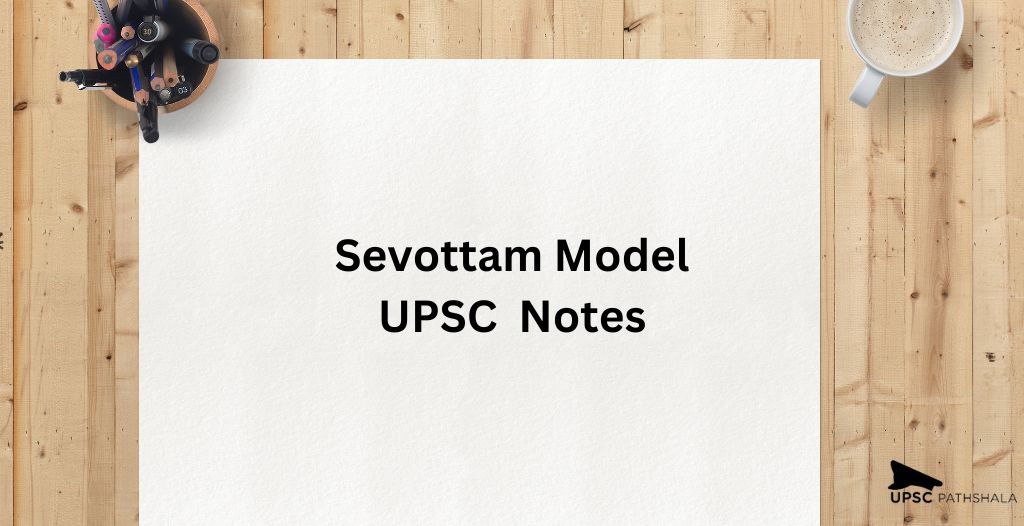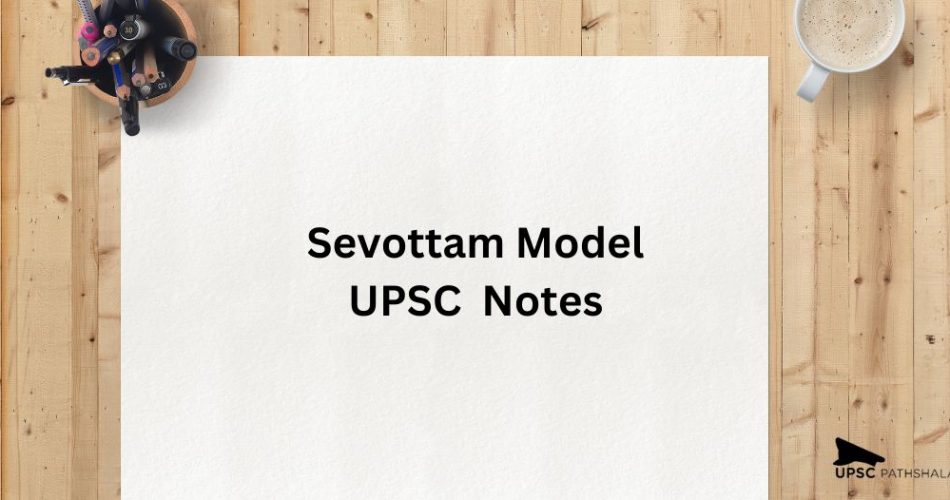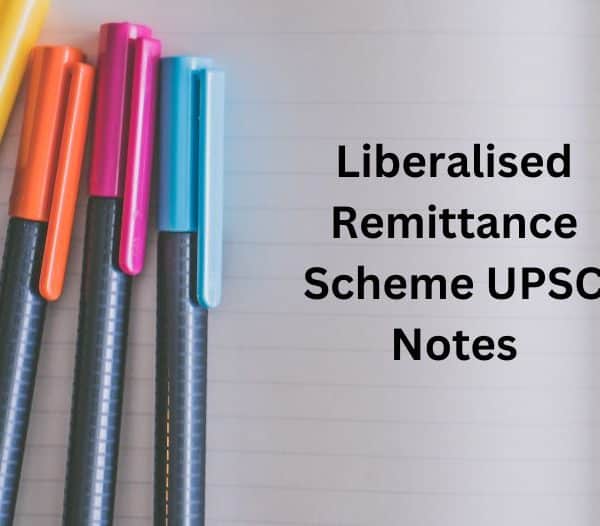Sevottam Model is a framework for citizen-centric service delivery developed by the Department of Administrative Reforms and Public Grievances (DARPG) in India. It aims to improve the quality of public services provided by government agencies and enhance the satisfaction of citizens.
The Sevottam Model comprises three components:
- Service Delivery Capability: This component focuses on the capacity of an organization to provide services to citizens. It includes various aspects such as infrastructure, technology, human resources, and processes.
- Public Grievance Redressal: This component is concerned with addressing the grievances of citizens related to public services. It includes mechanisms for receiving, processing, and resolving complaints.
- Service Delivery Outcomes: This component measures the effectiveness of public services in meeting the needs and expectations of citizens. It includes aspects such as accessibility, timeliness, quality, and cost-effectiveness.
Also Read: Constitutional Morality: Check Out the UPSC Notes and Prepare for the UPSC CSE!
For UPSC Exam Preparation, it is essential to understand the Sevottam Model and its significance in improving public service delivery. It is also crucial to be aware of the initiatives taken by the government to implement the Sevottam Model in various sectors such as health, education, and rural development.
Sevottam Model for UPSC
The Sevottam Model is a framework developed by the Department of Administrative Reforms and Public Grievances (DARPG) in India to improve the quality of public services provided by government agencies and enhance citizen satisfaction. The model is based on the principle of citizen-centric service delivery, which means that all government services should be designed and delivered with the needs and expectations of citizens in mind.
The Sevottam Model comprises three components: Service Delivery Capability, Public Grievance Redressal, and Service Delivery Outcomes. Let’s take a closer look at each of these components:
- Service Delivery Capability: This component focuses on the capacity of an organization to provide services to citizens. It includes various aspects such as infrastructure, technology, human resources, and processes. The objective of this component is to ensure that the organization has the necessary resources and systems in place to provide high-quality services to citizens.
- Public Grievance Redressal: This component is concerned with addressing the grievances of citizens related to public services. It includes mechanisms for receiving, processing, and resolving complaints. The objective of this component is to provide a fair, transparent, and efficient system for citizens to voice their grievances and receive timely redressal.
- Service Delivery Outcomes: This component measures the effectiveness of public services in meeting the needs and expectations of citizens. It includes aspects such as accessibility, timeliness, quality, and cost-effectiveness. The objective of this component is to ensure that the services provided by the organization are aligned with the needs and expectations of citizens and are delivered in an efficient and effective manner.
UPSC Exam Preparation Tips for the Sevottam Model
Here are some tips for UPSC Exam Preparation on the Sevottam Model:
- Understand the components of the Sevottam Model in detail and their interdependencies.
- Analyze case studies and examples of the Sevottam Model in action to gain practical insights into its implementation.
- Study the initiatives taken by the government to implement the Sevottam Model in various sectors.
- Stay updated on the latest developments and advancements in the Sevottam Model.
- Practice answering questions related to the Sevottam Model to improve your comprehension and analytical skills.
Also Read: What are Electoral Bonds? Check Out Our UPSC Notes for This Prominent Topic
UPSC Notes Preparation for the Sevottam Model
Here are some tips for UPSC Notes Preparation on the Sevottam Model:
- Make a detailed note on each component of the Sevottam Model, including its objectives, scope, and key features.
- Include examples and case studies in your notes to illustrate the practical application of the Sevottam Model.
- Use diagrams and flowcharts to visualize the relationships between the different components of the Sevottam Model.
- Compile a list of government initiatives and programs that have been implemented using the Sevottam Model and include them in your notes.
- Use mnemonic devices and summary sheets to help you remember the key points and concepts related to the Sevottam Model.
Conclusion
In conclusion, the Sevottam Model is a crucial framework that aims to enhance the quality of public services provided by government agencies in India. It focuses on citizen-centric service delivery, with an emphasis on service delivery capability, public grievance redressal, and service delivery outcomes. Understanding the Sevottam Model is an essential part of UPSC Exam Preparation, and students should analyze case studies and examples to gain practical insights into its implementation.
As a comprehensive online learning platform for UPSC Exam Preparation, UPSC Pathshala offers students access to high-quality study materials, expert guidance, and personalized feedback to help them succeed in their exams. With an emphasis on interactive learning and practical application, UPSC Pathshala is an ideal choice for students looking to prepare for the UPSC exam efficiently and effectively.
Also Read: Election Law Amendment Bill 2021 UPSC: Note Down All the Key Points for UPSC Preparation
In addition, UPSC Pathshala offers courses and coaching for a wide range of UPSC Exam Preparation topics, including the Sevottam Model. With its experienced faculty, innovative teaching methods, and comprehensive study materials, UPSC Pathshala is the perfect destination for students looking to enhance their knowledge and skills on the Sevottam Model.
In conclusion, by choosing UPSC Pathshala for your UPSC Exam Preparation, you will not only gain a deep understanding of the Sevottam Model but also receive personalized guidance and support to achieve your academic goals.
Also Read: Anti Dumping Duty UPSC: Get All The Important Notes on This Topic Here







